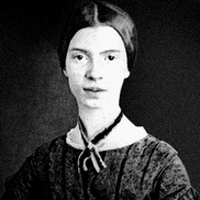A Bird came down the Walk by Emily Dickinson: Summary and Analysis
A Bird came down the Walk was first published in 1891 in the second collection of Dickinson's poems. The present poem, like most others, illustrates the distinctive quality of Emily Dickinson, that is, even the most commonplace themes is invested with freshness and originality in the hands of Emily Dickinson. The poem describes a bird that comes across the poet in a garden. But the poet's minute observation, the precision of her words and the freshness of metaphors make the poem uniquely her own.

Emily Dickinson (1830-1886)
A bird came across the poet in a garden pathway. The bird did not notice that the poet had seen him. He hit an angleworm and ate it raw. The curtness of the last two lines of the stanza suggests the swiftness of the bird's hitting and eating the worm. Having dined on the worm, the bird drank dew-drops from nearby grass and then swiftly hopped sideways to a wall to give way to beetle. The poet's acute observation of the whole scene is remarkable for its vividness and clarity. Perhaps perching on the wall, the bird glanced rapidly all around. His rapid eyes sparkled with fright and looked like beads. The expression "frightened beads" is very fresh and original. The fright of the bird is further attested by the stir of his velvet head. It appeared like one in danger. The poet offered a crumb very cautiously (lest he should fly away) to the bird. Yet, the bird unrolled its feathers and softly rowed itself home. The word 'rowed' is remarkable to describe the bird's flight.
In this poem, Dickinson exhibits her extraordinary poetic powers of observation and description of a simple incident of a bird. The speaker passionately portrays the bird as it eats a worm, brushes at the grass, hops by a beetle, and looks around fearfully. But the most incredible feature of this poem is the imagery of flying away of bird in the last stanza. She compares the wings to the oars which row the beautiful bird homewards. The bird is associated with a boat and the open blue sky to the ocean in the poem. The softness with which the bird rowed itself home is presented here in a series of pictures. It is like the ease and softness with which oars, while rowing, divide the ocean. It is like the splash less leap of butterflies in some afternoon, in some river. The movement of the bird is very silent as the use of the word ‘softer’ indicates. The wings of the bird are more silent while flying than the oars that divides the metaphorical water while sailing. The poet then provides an image of butterflies flying around at noon. The movement of the butterflies is very molten and smooth. The poet visualizes these butterflies swimming without any ripples and splash.
Cite this Page!
Shrestha, Roma. "A Bird came down the Walk by Emily Dickinson: Summary and Analysis." BachelorandMaster, 3 Dec. 2017, bachelorandmaster.com/britishandamericanpoetry/a-bird-came-down-the-walk-summary-analysis.html.
Related Topics
Much Madness is Divinest Sense: Analysis
Renunciation: Summary and Analysis
Because I could not Stop for Death: Analysis
I Heard a Fly Buzz: Summary and Analysis
After Great Pain, a Formal Feeling Comes: Analysis
Success is Counted Sweetest: Summary and Analysis
I taste a liquor never brewed: Summary and Analysis
Hope is the Thing with Feathers: Analysis
I like to see it lap the Miles: Summary and Analysis
I had something that I called mine: Analysis
If I should Die: Summary and Analysis
I'm Nobody! Who are you?: Summary and Analysis
These are the days when the Birds come back
What Inn is this: Summary and Analysis
Exultation is the going: Summary and Analysis
Of Bronze-and Blaze: Summary and Analysis
A Clock Stopped: Summary and Analysis
I felt a Funeral, in my Brain: Summary and Analysis
Safe in their Alabaster Chambers: Analysis
There's a certain Slant of light: Summary and Analysis
To fight aloud, is very brave: Summary and Analysis
I like a look of Agony: Summary and Analysis
Bring me the sunset in a cup: Summary and Analysis
The day came slow-till Five o'clock: Analysis
 |
bachelorandmaster.com |